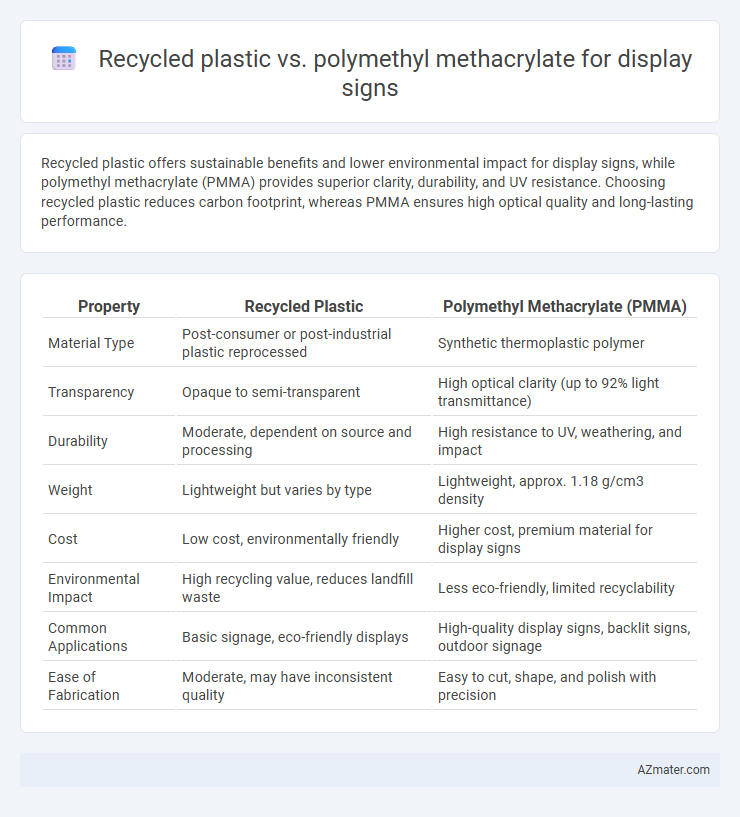Recycled plastic offers sustainable benefits and lower environmental impact for display signs, while polymethyl methacrylate (PMMA) provides superior clarity, durability, and UV resistance. Choosing recycled plastic reduces carbon footprint, whereas PMMA ensures high optical quality and long-lasting performance.
Table of Comparison
| Property | Recycled Plastic | Polymethyl Methacrylate (PMMA) |
|---|---|---|
| Material Type | Post-consumer or post-industrial plastic reprocessed | Synthetic thermoplastic polymer |
| Transparency | Opaque to semi-transparent | High optical clarity (up to 92% light transmittance) |
| Durability | Moderate, dependent on source and processing | High resistance to UV, weathering, and impact |
| Weight | Lightweight but varies by type | Lightweight, approx. 1.18 g/cm3 density |
| Cost | Low cost, environmentally friendly | Higher cost, premium material for display signs |
| Environmental Impact | High recycling value, reduces landfill waste | Less eco-friendly, limited recyclability |
| Common Applications | Basic signage, eco-friendly displays | High-quality display signs, backlit signs, outdoor signage |
| Ease of Fabrication | Moderate, may have inconsistent quality | Easy to cut, shape, and polish with precision |
Introduction to Display Sign Materials
Recycled plastic offers an eco-friendly and cost-effective solution for display signs, featuring durability and resistance to impact and weather conditions. Polymethyl methacrylate (PMMA), commonly known as acrylic, provides superior clarity, UV resistance, and excellent weatherability, making it ideal for vibrant, long-lasting displays. Both materials serve diverse signage needs, with recycled plastic emphasizing sustainability and PMMA prioritizing high optical quality.
Overview of Recycled Plastic in Signage
Recycled plastic offers an eco-friendly and cost-effective alternative for display signage, known for its durability and resistance to weathering and UV rays. It supports sustainability goals by reducing landfill waste and conserving resources while maintaining visual appeal through various finishing options. Common types, such as HDPE and PET, provide versatile solutions adaptable to indoor and outdoor signage needs.
Understanding Polymethyl Methacrylate (PMMA)
Polymethyl methacrylate (PMMA) is a transparent thermoplastic commonly used for display signs due to its high optical clarity, weather resistance, and UV stability, outperforming recycled plastics in visual quality and durability. Unlike recycled plastics, PMMA maintains consistent mechanical properties and is less prone to discoloration, making it ideal for long-term outdoor signage applications. Its ease of fabrication and resistance to environmental factors ensure superior longevity and aesthetic appeal in display sign manufacturing.
Environmental Impact: Recycled Plastic vs PMMA
Recycled plastic significantly reduces landfill waste and lowers carbon emissions compared to producing new Polymethyl Methacrylate (PMMA), which requires energy-intensive extraction of petrochemicals. While PMMA offers clarity and durability for display signs, its production generates higher greenhouse gases and is less biodegradable than recycled plastic alternatives. Using recycled plastic supports circular economy initiatives by minimizing resource consumption and promoting material reuse in signage applications.
Durability and Lifespan Comparison
Recycled plastic offers moderate durability but may degrade faster under prolonged UV exposure compared to polymethyl methacrylate (PMMA), which provides superior resistance to weathering and impact. PMMA typically maintains clarity and structural integrity for 10 to 15 years, making it ideal for long-term display signs, while recycled plastic signs generally have a shorter lifespan of around 5 to 7 years due to potential material fatigue. The higher scratch resistance and stability of PMMA contribute to its preferred use in applications demanding extended durability and aesthetic retention.
Visual and Aesthetic Qualities
Recycled plastic often presents with slight color variations and surface imperfections, which can impact the clarity and vibrancy of display signs. Polymethyl methacrylate (PMMA) offers superior optical clarity, high gloss, and excellent color retention, making it ideal for visually striking and professional-grade signage. PMMA's smooth surface enhances light transmission and provides a sleek, polished aesthetic unmatched by most recycled plastics.
Cost Efficiency and Budget Considerations
Recycled plastic offers a cost-efficient alternative for display signs, with lower raw material expenses and reduced environmental impact compared to Polymethyl methacrylate (PMMA). PMMA, while providing superior clarity and durability, typically incurs higher initial costs and maintenance budgets, making it less suitable for budget-conscious projects. Choosing recycled plastic aligns with sustainability goals and minimizes production costs, enhancing overall budget efficiency without significantly compromising quality.
Customization and Fabrication Flexibility
Recycled plastic offers limited customization and fabrication flexibility compared to polymethyl methacrylate (PMMA), which excels in versatile shaping, cutting, and finishing options for display signs. PMMA allows precise engraving, thermoforming, and polishing, making it ideal for intricate and high-quality custom signage. Recycled plastic's constraints in moldability and surface smoothness reduce its suitability for detailed and visually appealing custom displays.
Applications and Suitability for Different Environments
Recycled plastic offers eco-friendly and cost-effective solutions for display signs, excelling in outdoor environments due to its high resistance to moisture, UV rays, and impact, making it suitable for long-term, weather-exposed applications. Polymethyl methacrylate (PMMA), also known as acrylic, provides superior optical clarity, weather resistance, and rigidity, ideal for high-visibility indoor and outdoor signage where aesthetic appeal and durability are priorities. While recycled plastic is preferred for budget-conscious and sustainable projects exposed to rough conditions, PMMA is favored for premium displays requiring scratch resistance and enhanced light transmission in controlled or semi-exposed environments.
Future Trends in Sustainable Display Sign Materials
Recycled plastic materials are gaining traction in the display sign industry due to their reduced environmental impact and cost-effectiveness, offering a sustainable alternative to traditional materials. Polymethyl methacrylate (PMMA), known for its clarity and durability, is being enhanced with bio-based and recycled content to improve sustainability without compromising performance. Future trends indicate a shift towards hybrid composites and advanced recycling technologies that optimize the lifespan and recyclability of display sign materials, aligning with circular economy principles and increasing regulatory pressures for eco-friendly solutions.

Infographic: Recycled plastic vs Polymethyl methacrylate for Display sign
 azmater.com
azmater.com